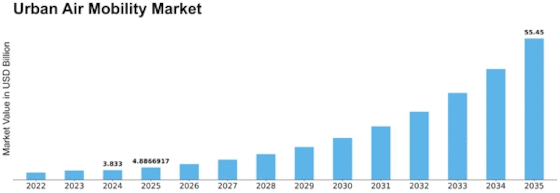Why Urban Air Mobility Is Set to Redefine Global Mobility Ecosystems

Introduction
Urban Air Mobility (UAM) is being hailed as the next frontier in transportation – a paradigm shift from congested roads to open skies. With its promise of fast, sustainable, and efficient aerial mobility, the UAM market is capturing global attention. This article offers a holistic market analysis, spotlighting the size, share, growth, trends, and regional perspectives, along with the main challenges and strategic levers.
Market Size & Share Overview
Based on data from MRFR, the UAM market size stood at USD 3.833 billion in 2024, and it is forecasted to reach USD 55.45 billion by 2035, at a CAGR of 27.49%. This explosion in value is supported by rising investments, regulatory momentum, and breakthroughs in aircraft technology.
In terms of market share, the competition is heating up. Leading firms include Joby Aviation, Volocopter, Lilium, Airbus, Boeing, Bell Textron, EHang, Hyundai, and Kitty Hawk, among others. These companies are not only designing next-gen eVTOLs, but also building ecosystems (vertiports, air traffic systems) to support large-scale deployment.
Growth and Trend Drivers
- Urban Congestion & Demand for Speed
As mega‑cities grow, traditional transport is increasingly inadequate. UAM addresses this with point-to-point aerial travel, dramatically reducing commute times. - Sustainable Mobility
UAM solutions, especially electric aircraft, align with global decarbonization goals and environmental regulations. - Funding & Partnerships
There’s a surge in private and public funding, from VC to government grants, enabling R&D and infrastructure deployment. - Digital Infrastructure
Development of AI and autonomous systems is not just for aircraft, but also for managing air traffic, optimizing routes, and charging cycles. - Regulatory Pathways
Aviation authorities globally are actively developing frameworks to regulate UAM, certifying eVTOLs, and enabling commercial services.
Regional Landscape & Analysis
- North America: With its mature aerospace industry, deep-pocketed investors, and regulatory engagement, North America is the UAM powerhouse. The U.S. dominates, with significant R&D, pilot projects, and industry leaders.
- Europe: Europe’s push for sustainable cities and green transit makes it a fertile zone for UAM. Regulatory alignment, R&D clusters, and public-private cooperation drive momentum.
- Asia-Pacific: The region is projected to show the fastest growth. Rapid urbanization, government backing, and home-grown innovators (like EHang) are propelling UAM adoption.
- South America: Though still early in the UAM lifecycle, emerging urban centres offer a testbed for aerial mobility. Unlocking this will require infrastructure investment, public-private initiatives, and regulatory clarity.
- Middle East & Africa: In the Middle East, visionary cities like Dubai and Abu Dhabi are planning for aerial mobility—drawing on their innovation-driven strategies. In Africa, rising urbanization presents potential, but infrastructure and regulatory gaps must be bridged.
Key Challenges to Overcome
- Safety and Certification: Ensuring collision avoidance, airborne safety, and standardized certification is non-trivial and resource-intensive.
- High Capital Expenditure: Building vertiports, charging infrastructure, and fleets of eVTOLs requires major investment.
- Public Perception: Concerns over noise, privacy, and risk may slow public adoption unless addressed via outreach and regulation.
- Regulatory Complexity: Harmonizing airspace rules, licensing, and standards across regions is complex and requires multilateral coordination.
Strategic Levers for Growth
- Create Pilot Corridors: Establish dedicated UAM corridors in exemplar cities to test and validate business models and safety protocols.
- Leverage Public-Private Cooperation: Governments, city planners, and private firms should forge partnerships to co-develop infrastructure and regulatory frameworks.
- Scaling Infrastructure Gradually: Vertiports and charging stations should be built modularly, scaling as demand materializes.
- Foster Innovation Ecosystems: Support startups and research institutions to innovate in propulsion, autonomy, and air traffic management.
- Educate & Build Trust: Implement public education campaigns, community pilots, and demonstration flights to build acceptance.
The Path Forward: Future Outlook
In the next decade, cargo logistics and emergency medical services could be among the fastest-growing applications for UAM, driven by efficiency and speed. Meanwhile, vertiport networks integrated into urban fabric will become critical infrastructure. As regulatory frameworks mature and public confidence strengthens, UAM is poised to transition from a futuristic concept to a practical, everyday mobility solution.
Conclusion
The Urban Air Mobility market, characterized by strong growth, increasing market share, and disruptive trends, is set to redefine the transportation paradigm. While challenges remain, strategic investments, collaborative innovation, and scalable infrastructure development can unlock enormous value. Stakeholders across regions must act with foresight and partnership to make this aerial future a reality.
- Art
- Causes
- Crafts
- Dance
- Drinks
- Film
- Fitness
- Food
- Spellen
- Gardening
- Health
- Home
- Literature
- Music
- Networking
- Other
- Party
- Religion
- Shopping
- Sports
- Theater
- Wellness
